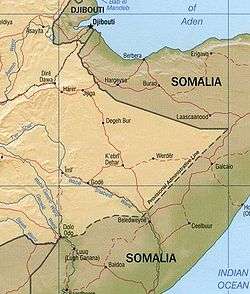1964 Ethiopian–Somali Border War
The 1964 Ethiopian–Somali Border War was a short war between the Somali Republic and the Ethiopian Empire in which Somalia attacked several towns along the Ethiopian border but was fairly quickly repulsed.
| 1964 Ethiopian–Somali Border War | |||||||
|---|---|---|---|---|---|---|---|
| |||||||
| Belligerents | |||||||
|
|
| ||||||
| Commanders and leaders | |||||||
|
|
| ||||||
Background

After the independence and unification of British Somaliland and the Trust Territory of Somaliland on July 1, 1960, one of the major goals of the Somali Republic was the unification of Greater Somalia, which included the Ogaden region in Ethiopia. The Somali government supported the Bale revolt led by Waqo Gutu that began in 1962.[2] On 16 June 1963, after the Ethiopian government attempted to collect taxes, Somali guerrillas started a minor insurgency at Hodayo, a watering place north of Werder. The guerrillas were greatly supported by the Somali government and operated in lowland Hararghe and Bale provinces. Their numbers eventually grew to about 3,000, but they never posed a serious threat to the government.[3]
Course of the War
In early February 1964, the Somali Army attacked Ethiopian police units at Inaguha (southeast of Jijiga), Dabagoryale (northeast of Aware), Ferfer, Yät, and Dolo, with most of its forces attacking Togochale (northeast of Jijiga). In response, Ethiopia sent an airborne company, an infantry battalion, an artillery battery, and a mechanized platoon with M24 tanks to Togochale,[4] and with support from the air force, which began punitive strikes across the southwestern frontier against Feerfeer (northeast of Beledweyne) and Galkacyo, the Somali offensive was quickly repulsed.
Aftermath
On 6 April 1964, Somalia and Ethiopia agreed to a cease-fire. At the end of the month, the two sides signed an accord in Khartoum, Sudan, agreeing to withdraw their troops from the border, cease hostile propaganda, and start peace negotiations.[5][6] The border war also led the Organisation of African Unity to pass the Cairo declaration in July 1964 that called on all member states to respect existing borders.[7] Somalia's loss mostly marked the end of the Somali insurrection in the Ogaden for a time,[3] but it would be restarted before Somalia's next attempt to annex the Ogaden with the Ogaden War in 1977.
References
Notes
- "The History Guy: Ethiopia-Somalia Wars and Conflicts". Retrieved 21 July 2017.
- Waal, Alexander De (1991). Evil Days: Thirty Years of War and Famine in Ethiopia. Human Rights Watch. p. 67. ISBN 978-1-56432-038-4.
- Waal, Alexander De (1991). Evil Days: Thirty Years of War and Famine in Ethiopia. Human Rights Watch. p. 71. ISBN 978-1-56432-038-4.
- Ayele 2014, p. 22.
- "Somalia profile - Timeline". BBC Africa. 4 January 2018. Retrieved 14 May 2018.
- "Onwar". Retrieved 4 January 2018.
- "RESOLUTIONS ADOPTED BY THE FIRST ORDINARY SESSION OF THE ASSEMBLY OF HEADS OF STATE AND GOVERNMENT HELD IN CAIRO, UAR, FROM 17 TO 21 JULY 1964" (PDF).
Bibliography
- Ayele, Fantahun (2014). The Ethiopian Army: From Victory to Collapse. Northwestern University Press.